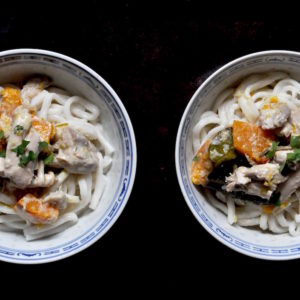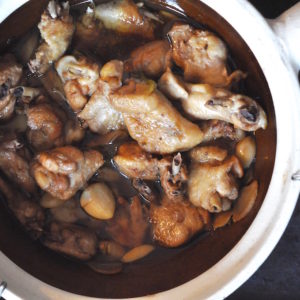Kurdish Fried Chicken
Last weekend the IK attempted to update her computer. The last time she tried doing so, the hard drive crashed. This time, she discovered the external hard drive she’d purchased less than a year ago had ceased functioning. In September 2016.
As in, the IK’s computer had not been backed up in ten months.
Your hostess thus dashed off to Bay Area Rapid Transit, hieing herself to the nearest vendor of external hard drives. There a child salesperson sold her a small box, an object he promised would save the day. And her Mac. The IK paid in plastic on another computer. She rushed back home. Following the nonexistent directions, she plugged the small box into her Mac, with its 142.08 GB of memory, none of it backed up since September of 2016.
The small box did not work.
Your hostess is often called anxious by those who know her. Also highly strung and nervous.
And people wonder why.
Your hostess never, ever questions the wellsprings of her multiple anxieties.
Her spouse decided to reformat the box. As a challenge.
Your hostess demurred. Why not return said box to the child seller?
By now your hostess’s spouse had pulled his chair up to the unbacked-up, vulnerable machine, opened its hard drive, and commenced HTML surgery.

The above is now backed up.
—
Into the kitchen.
Kurdish Fried Chicken–the full title of this recipe is Kurdish Fried Chicken in Broth–has always struck me as counterintuitive by virtue of its unusual cooking method. Chicken pieces are cleaved into bite-sized pieces, marinated in salted lemon juice, then lightly fried. The chicken finishes cooking in its marinade, grated onion, turmeric, cumin, and water. The result is a surprisingly gentle-tasting, light dish, good either hot or at room temperature.

The recipe comes from Naomi Duguid’s Taste Of Persia, and like so many of her recipes, demands little by way of specialized techniques or equipment. If you use bone-in chicken, you’ll need a heavy knife or cleaver. That’s it.

Many Middle Eastern recipes begin with hand-grated onions. Grate an onion by hand and you’ll have a silken mush that melts during cooking. Even professed onion-haters–like the person I married–happily consume the results.

Kurdish Fried Chicken is no exception. As my hands were killing me, I tried taking a short cut this once, grating the onion in the food processor. I met with mixed results. Using the grating attachment, resulted in rice-sized shreds that floated in the finished dish. Persian cooks are famed for their finesse. You won’t find pieces of onion bobbing in their dishes.

Ideally, you’ll be able prepare Kurdish Fried Chicken as the Kurds do, grating your onions by hand. If, like me, you must use the processor, here are some options for a more polished final presentation:
–strain the finished broth
–serve the dish using a slotted spoon
The original recipe calls for bone-in chicken legs or breasts, I used bone-in thighs–what I had– with great success.
About the rice pictured here. I had some plain white rice in need of eating up, and made a sort of fake Kurdish Red Rice, also from Taste Of Persia, by stirring in a goodly amount of tomato paste, salt, and some chopped cilantro.

The brothy nature of this dish also cries out for flatbreads, and an herb plate.
Kurdish Fried Chicken in Broth
Yield: 2 servings, easily increased
prep time: minimum 1 hour for marinating chicken and 1 hour to cook.
Recipe from Naomi Duguid’s Taste Of Persia
1-2 large, fresh lemons to yield 1/4 cup juice, plus optional additional lemon for serving
1 pound bone-in chicken breasts, thighs, or legs
2 teaspoons sea salt, for marinade, plus additional to taste
a generous cup sunflower or olive oil, for frying; amount depends on your pan
1 large or 2 medium onions
1/2 teaspoon turmeric
1 1/4 teaspoon ground cumin
1/4 cup minced cilantro, scallions, or a mixture of the two
Instructions
Set a small strainer over a measuring cup and squeeze out 1/4 cup fresh lemon juice. I save the spent lemons to help sterilize the cutting board and sink after cleaving chickens, next.
Using a cleaver or large, heavy knife, chop the chicken into bite-sized pieces (see photograph for size) and place them in the bowl. Now wash your cleaver and cutting board with hot soapy water. Run your spent lemons over the board and your sink.
Pour the lemon juice over the chicken. Add the salt, rubbing it into the chicken pieces with your hands. Cover the bowl and refrigerate at for at least an hour.
While the chicken marinates, grate the onion. See discussion in blog, above, or in notes, below, regarding grating manually or by machine. Grind cumin if necessary. Mince cilantro and/or slice scallions. Prepare rice, if you plan to serve it (highly advised). Prepare herb plate, if serving.
To cook the chicken:
Place a 12-14 inch heavy sauté or frying pan on the stove. Add about 1/4 inch of oil; set the burner on medium high heat. Carefully add the chicken pieces to pan, allowing the marinade to drip back into the bowl (do not discard marinade). Do not crowd pan; cook chicken in batches if necessary or, if you are dextrous, use two pans, adding oil if necessary.
Fry chicken until lightly touched with gold, turning occasionally, for about 15 minutes. You aren’t looking to cook chicken through, just to get a nice color on it. If oil is spattering terribly or chicken is burning, turn heat down a bit.
Transfer chicken pieces to a 4 or 5 quart pot. Add the marinade, onions, turmeric, cumin, and enough water to cover–about a cup or so, depending on your pot.
Bring the liquid to a boil, then turn the heat down to simmer. Cook the chicken for about 45 minutes, stirring occasionally, until chicken is tender and cooked through.
Taste for salt–it may need quite a bit. I also find the finished dish benefits from an additional squeeze of fresh lemon juice.
Sprinkle cilantro and/or scallions over and serve.
Kurdish Fried Chicken in Broth keeps well, covered, up to three days, refrigerated.
Notes: Duguid’s recipe calls for 2 1/2-3 pounds of chicken. Although I used less poultry, I did not alter any other amounts.
I used chicken thighs. The original recipe calls for bone-in breasts or legs.
Grating the onions by hand gives a finer result, allowing them to dissolve completely in the cooking broth. Grating with a food processor leaves rice-sized bits in the final dish. If you opt to go the processor route, you can either live with this, strain the cooked broth, or serve the dish with a slotted spoon.
I deal with used cooking oil by allowing it to cool, then pouring it off into a canning jar, which I keep in the refrigerator until full. Then I toss it. If anyone has a better idea, I’d love to hear it.





